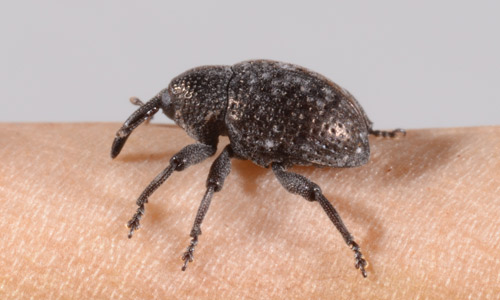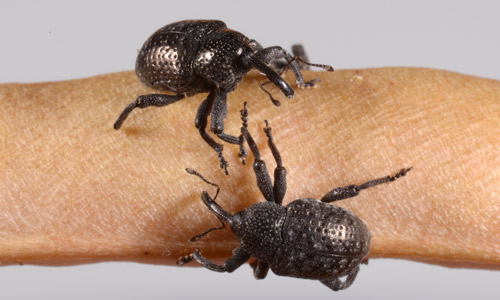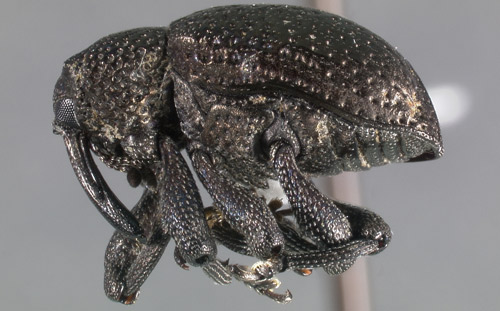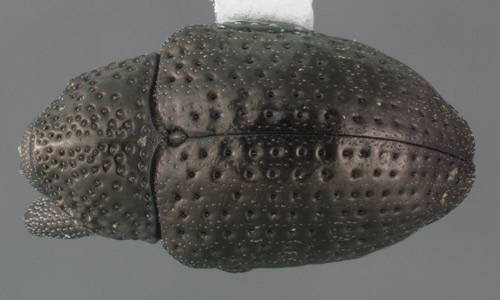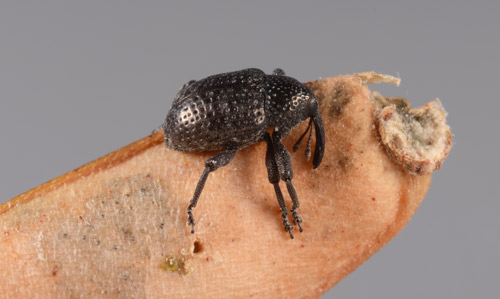common name: cowpea curculio
scientific name: Chalcodermus aeneus Boheman (Insecta: Coleoptera: Curculionidae)
Distribution - Life Cycle and Description - Host Plants - Damage - Natural Enemies - Management - Selected References
Distribution (Back to Top)
The cowpea curculio, Chalcodermus aeneus Boheman, occurs primarily to the southeastern states, from Virginia to Florida in the East, and west to Texas and Oklahoma. Occasionally it is reported in more northern states, but causes no damage there. It also is reported from Central and South America.
Life Cycle and Description (Back to Top)
Cowpea curculio overwinters in the adult stage, emerging in April or May to begin feeding. Oviposition usually does not occur until cowpea is available, which is often June or July. There appear to be two generations annually in Alabama, but only one in Virginia. However, the adults are long-lived, often surviving for several months, so the generations are indistinct. About 30 to 40 days are required for a complete generation.
Figure 1. Adult cowpea curculio, Chalcodermus aeneus Boheman. Photograph by Lyle J. Buss, University of Florida.
Figure 2. Adult cowpea curculios, Chalcodermus aeneus Boheman. Photograph by Lyle J. Buss, University of Florida.
Figure 3. Adult cowpea curculio, Chalcodermus aeneus Boheman. Photograph by Lyle J. Buss, University of Florida.
Figure 4. Adult cowpea curculio, Chalcodermus aeneus Boheman, dorsal surface. Photograph by Lyle J. Buss, University of Florida.
Egg: The egg is oval in shape, and white in color. It measures about 0.9 mm long and 0.6 mm wide. Eggs are deposited in the pod of the host plant, or within the seed in the pod. The female deposits her eggs in feeding sites, with only a single egg deposited in each feeding puncture. Each female deposits, on average, about 112 eggs (range 30 to 280) during an oviposition period of about 45 days. Duration of the egg stage is about four (range three to six) days.
Larva: The larva is pale yellow in color, although the head and prothoracic plate are yellowish brown. The larva lacks legs, but bears deep furrows around its body. The body is thickest about one-third the distance between the head and anus, tapering gradually to a fairly pointed posterior end. The body bears stiff bristles. The larva attains a length of about 7 mm at maturity. There are four instars. Duration of the larval stage was reported to require about 9.4 days in Alabama, but only about six to seven days in Virginia. In the latter study, development times of the four instars averaged about 1, 1, 1, and 3.2 days, respectively.
Pupa: At completion of the larval stage the insect drops to the soil and burrows to a depth of 2.5 to 7.5 cm. During a prepupal period of about six (range three to 14) days the larva creates a pupal cell, and molts to the pupal stage. The pupa greatly resembles the adult in shape and size, but is yellowish white in color. Duration of the pupa is about 10 (range five to 19) days. After transformation to the adult, the beetle remains in the pupal cell for two to three days while it hardens, and then digs to the surface to emerge.
Adult: The adult is oval and robust in appearance. It is black in color, with a faint bronze tint. The mouthparts are elongate, slightly longer than the thorax, and only slightly curved. The thorax and elytra are marked with coarse punctures. The beetle measures 4.8 to 5.5 mm in length. Adults are most active during the morning and early evening, seeking shade during the heat of the day. They feign death and drop to the soil when disturbed. Beetles rarely fly. Adults overwinter in the soil and under leaves and other organic debris.
A good summary of cowpea curculio biology is given by Arant (1938). Additional useful observations were provided by Hetrick (1947).
Host Plants (Back to Top)
Cowpea curculio feeds principally on legumes, but other plants are sometimes consumed. Cowpea, snap bean, lima bean, and pea are the vegetables injured, but cowpea is the preferred host. Other crops attacked are cotton, soybean, and strawberry. Among weed host plants are cutleaf evening primrose, Oenothera laciniata; moss verbena, Verbena tenuisecta; wild bean, Strophostyles umbellata and S. helvola; purple cudweed, Gnaphalium purpureum; heartwing sorrel, Rumex hastatulus; sheep sorrel, Rumex acetocella; and spring vetch, Vicia sativa. Weeds and cotton are primarily attacked early in the year, before cowpea is available, but sicklepod, Senna obtusifolia is a host during the cowpea cropping season. Sudbrink et al. (1998) provide data on the seasonal sequence of hosts in Alabama.
Figure 5. Adult cowpea curculio, Chalcodermus aeneus Boheman, on a legume pod. Photograph by Lyle J. Buss, University of Florida.
Damage (Back to Top)
Legumes are damaged by both adult and larval stages, both of which feed on seeds within the pods. As noted earlier, the female deposits an egg at a site where she has been feeding. Small cavities and shallow furrows are typical forms of injury. In the spring, before pods are available, adults will feed on the lower epidermis of foliage, but this damage is insignificant.
Natural Enemies (Back to Top)
Several natural enemies have been reported, but most authors suggest that a fungus, Beauveria sp., is an important factor in winter survival of adults. The bacterium Serratia marcescens was observed to cause high mortality among larvae in South Carolina (Bell and Hamalle 1971).
Among parasitoids associated with cowpea curculio, only Myiophasia globosa (Townsend) (Diptera: Tachinidae) is consistently reported to be abundant. Arant (1938) also notes that unspecified ant species (Hymenoptera: Formicidae) and hot, dry weather affect larval survival. Russell (1981) observed that red imported fire ant, Solenopsis invicta Buren (Hymenoptera: Formicidae), significantly reduced the rate of successful pupation by cowpea curculio.
Management (Back to Top)
Sampling. Effective sampling techniques for this insect are lacking. Typically visual observation and sweep net sampling are used, but provide little predictive value. However, Riley et al. (2015) reported success at population monitoring using a baited Tedders-like trap baited with Grandlure.
Chemical control. Insecticides are commonly applied by conventional spray technology or ultra low volume techniques to protect against injury by curculio (Dupree 1970, Chalfant and Young 1988); adults are the usual target. Usually one or more applications are made prior to pod development, followed by insecticide treatments at three to five day intervals during pod growth. Insecticides directed to the soil beneath cowpea plants also are beneficial because adults often aggregate there during the heat of the day (Chalfant 1973b). Treatment of mature pods is not necessarily beneficial (Chalfant et al. 1982). Insecticide resistance has become a problem
for some classes of insecticides (N'Guessan and Chalfant 1990).
Cultural control. Because the adult rarely flies, but reaches its host plant principally by walking, crop rotation is beneficial. Also, tillage and destruction of alternate crop and weed hosts, and crop residue, will destroy overwintering beetles. These insects often feed early in the season on snap beans before moving to cowpea (Riley et al. 2015).
Host plant resistance. Considerable effort has been devoted to the identification of resistance among cowpea varieties to cowpea curculio. Varieties vary considerably in their resistance to attack (Chambliss & Hunter 1997). Pod wall (hull) thickness has been identified as a key factor in conferring resistance, and several commercially available varieties possess this desirable trait (Chalfant et al. 1972, Cuthbert and Davis 1972). However, when confronted with high curculio densities, these varieties do not impart complete protection, so they are best considered as part of a damage reduction program.
Biological control. Entomopathogenic fungi have been evaluated for suppression of cowpea curculio. Strains of both Metarhizium anisopliae and Beauveria bassiana are effective under experimental conditions (Bell and Hamalle 1971, Daoust and Pereira 1986), but commercial products are not yet available.
Selected References (Back to Top)
- Arant FS. 1938. Life history and control of the cowpea curculio. Alabama Agricultural Experiment Station Bulletin 246. 34 pp.
- Bell JV, Hamalle RJ. 1971. A bacterium and dipterous parasite in wild populations of cowpea curculio larvae: effects of treatment with spores of Metarrhizium anisopliae. Journal of Invertebrate Pathology 17: 256-259.
- Capinera JL. 2001. Handbook of Vegetable Pests. Academic Press, San Diego. 729 pp.
- Chalfant RB. 1973b. Cowpea curculio: control in southern Georgia. Journal of Economic Entomology 66: 727-729.
- Chalfant RB, Young JR. 1988. Cowpea curculio, Chalcodermes aeneus Boheman (Coleoptera: Curculionidae); insecticidal control on the southern pea in Georgia, 1980-1986. Applied Agricultural Research 3: 8-11.
- Chalfant RB, Suber EF, Canerday TD. 1972. Resistance of southern peas to cowpea curculio in the field. Journal of Economic Entomology 65: 1679-1682.
- Chalfant RB, Mullinix B, Nilakhe SS. 1982. Southern peas: interrelationships among growth stage, insecticide applications, and yield in Georgia. Journal of Economic Entomology 75: 405-409.
- Chambliss OL, Hunter AG. 1997. Vigna unguiculata germplasm evaluated for resistance to insects, pp. 285–291 In Singh BB, Mohan Raj DR, Dashiell KE, Jackai LEN (eds.) Advances in Cowpea Research, International Institute of Tropical Agriculture. Ibidan, Nigeria.
- Cuthbert FP, Davis BW. 1972. Factors contributing to cowpea curculio resistance in southern peas. Journal of Economic Entomology 65: 778-781.
- Daoust RA, Pereira RM. 1986. Survival of Beauveria bassiana (Deuteromycetes: Moniliales) conidia on cadavers of cowpea pests stored outdoors and in laboratory in Brazil. Environmental Entomology 15: 642-647.
- Dupree M. 1970. Ultra-low-volume insecticide sprays for control of the cowpea curculio. Journal of the Georgia Entomological Society 5: 39-41.
- Hetrick LA. 1947. The cowpea curculio: its life history and control. Virginia Agricultural Experiment Station Bulletin 409. 23 pp.
- N'Guessan KF, Chalfant RB. 1990. Dose response of the cowpea curculio (Coleoptera: Curculionidae) from different regions of Georgia to some currently used pyrethroid insecticides. Journal of Entomological Science 25: 219-222.
- Riley DG, Kicklighter J, Sparks Jr AN. 2015. Sampling of the cowpea curculio Chalcodermus aeneus, with traps in southern peas. Crop Protection 67: 72-76.
- Russell CE. 1981. Predation on the cowpea curculio by the red imported fire ant. Journal of the Georgia Entomological Society 16: 13-15
- Sudbrink Jr DL, Mack TP, Zehnder GW. 1998. Alternate host plants of cowpea curculio, (Coleoptera: Curculionidae) in Alabama. Florida Entomologist 81: 373-383.
